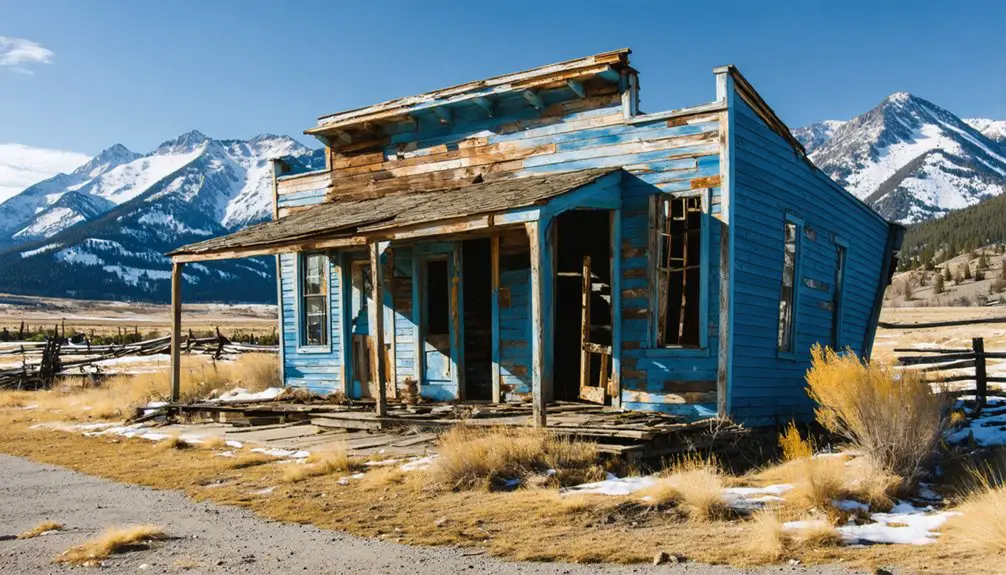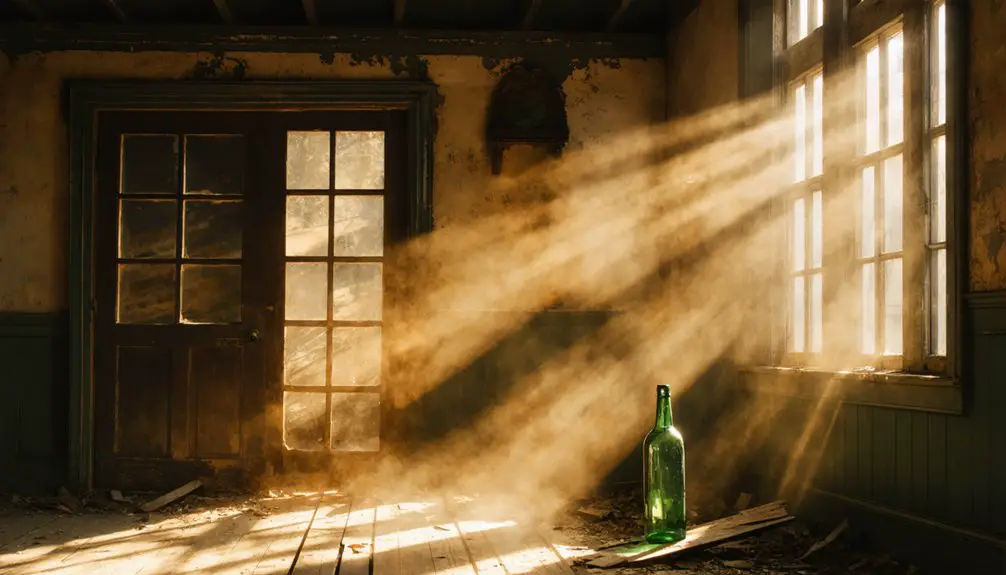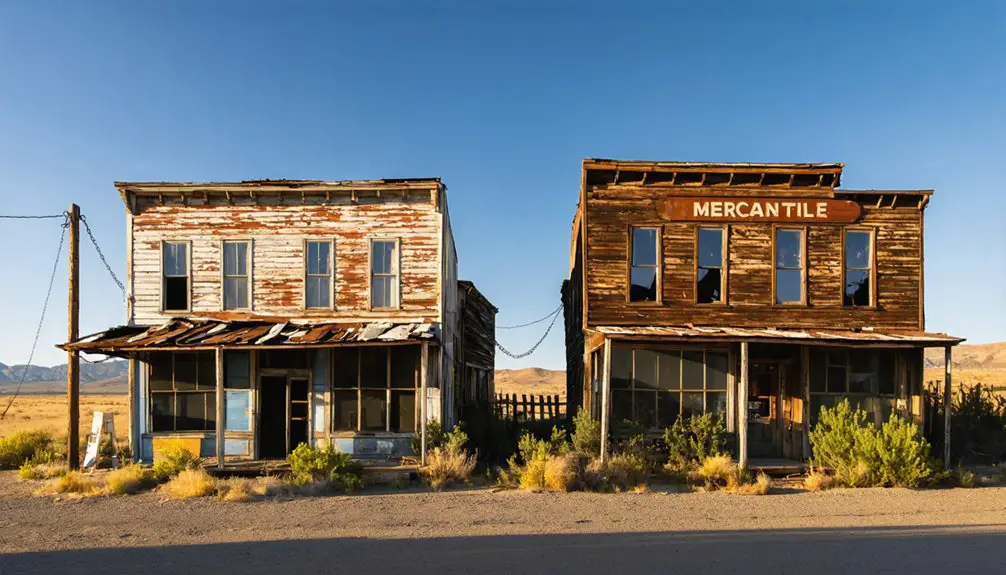When you explore Grant County’s ghost towns, you’ll discover the remnants of Oregon’s golden age of mining. Places like Fox and Austin tell stories of frontier determination, where populations once surged to 10,000 during the 1862 gold rush. Today, weathered stone buildings and abandoned stamp mills stand as evidence to boom-and-bust cycles that shaped these communities. From primitive placer mining to complex hard rock extraction, each site reveals layers of fascinating frontier history waiting to be uncovered.
Key Takeaways
- Canyon City emerged as the Northwest’s richest placer mining area, with its population exploding to 10,000 within ten days of discovery.
- Fox transitioned from a mining settlement to a ranching community, preserving its pioneer heritage through historic buildings and remote ranches.
- Mining towns featured essential establishments like general stores, saloons, and blacksmith shops that served as both commercial and social centers.
- Local buildings showcase frontier construction techniques using rough-hewn timber, stone foundations, and adaptations for mining operations.
- Heritage tourism now preserves ghost town history through building restoration, interpretive signage, and modern technological exploration tools.
The Rise and Fall of Mining Communities in Grant County
When gold was discovered on Whiskey Flat in 1862, Grant County’s landscape transformed virtually overnight as nearly 1,000 miners descended upon Canyon Creek within just ten days.
You’d have witnessed Canyon City‘s population explode to 10,000 as the region became the Northwest’s richest placer mining area, ultimately yielding over $26 million in gold.
The evolution of mining technology shaped community dynamics, as operations shifted from simple placer mining to complex hard rock extraction.
Chinese miners dominated the early days, particularly in the Granite District placers, establishing a significant presence in the region’s mining operations.
Many operations struggled due to limited water supply, which significantly impacted the ability to process ore effectively.
You’ll find traces of this shift in the changing fortunes of districts like Greenhorn and Quartzburg, where mining communities flourished and faded.
By the mid-20th century, most mining towns fell silent as economic factors and depleted resources took their toll.
Today, these ghost towns stand as a tribute to the freedom-seeking pioneers who shaped Grant County’s golden age.
Uncovering the History of Fox Ghost Town
While Fox never achieved the same mining prominence as other Grant County boomtowns, you’ll find its pioneer heritage preserved in the remote ranches and historic buildings that dot the Fox Valley landscape.
Following the pattern of early settlers who arrived forty years before 1902, the area established itself as a testament to frontier determination.
Similar to John Day’s evolution, the area transitioned from a mining focus to become primarily a stock-raising region.
The community’s Post Office, which operated from 1883 to 2002, served as a crucial hub for local ranchers and settlers who carved out their lives in this picturesque corner of northeastern Oregon.
If you visit today, you’ll discover a quiet reflection of rural American perseverance, where the birthplace of renowned artist Morris Graves and the enduring pastoral scenery offer glimpses into the region’s pioneering past.
Mining Glory Days
During the late 19th century, Fox emerged as a proof of Grant County’s remarkable mining expansion, drawing fortune seekers to its rich deposits of gold, silver, and platinum group elements. Located in one of fifteen Grant Counties across America, this Oregon settlement played a crucial role in the region’s development.
If you’d ventured into Fox during its heyday, you’d have witnessed primitive mining techniques yielding substantial returns along Canyon Creek, where over 1,000 miners first gathered at Whiskey Flat in 1862.
Your ghost town exploration would reveal how Fox transformed from a tent settlement into a bustling hub of commerce, complete with saloons like the “Mt. Hood” owned by William Davis, general stores, and blacksmith shops.
Though mining methods remained largely manual without modern machinery, the town’s early prospectors struck it rich enough to sustain a thriving community until the precious metals began to run dry.
Today, only four full-time residents remain in the once-prosperous mining settlement.
Daily Life Remnants
The traces of daily life in Fox still whisper stories through its weathered stone buildings and remnant structures along Highway 395. You’ll find evidence of frontier commerce where general stores, saloons, and blacksmith shops once served as bustling centers of daily routines.
Early settlers, shifting from temporary tent dwellings to permanent stone and cottonwood log homes, created a vibrant community where miners and merchants mingled. Like many county name entities, Fox represents one of numerous historic settlements that share similar naming patterns across America.
Community gatherings centered around local establishments like Hacheney’s store and similar merchants, while nearby ranches showcase the area’s evolution from mining to agricultural pursuits. The scenic Fox Valley provides a stunning backdrop to these historic remnants.
Today, you can explore the remaining buildings that housed these social hubs, including historically significant residences – one of which was the birthplace of artist Morris Graves, connecting you to Fox’s rich cultural heritage beyond its mining roots.
Austin’s Legacy: From Boom to Abandonment
Like countless mining settlements that dotted Oregon’s landscape in the late 19th century, Austin emerged from the promise of gold-rich quartz veins and placer deposits in Grant County’s rugged terrain.
Similar to the success of the Big Four hydraulic mine in Grants Pass, Austin’s mining operations ran continuously during its peak years. The town resembled early settlements like Buncom ghost town, which served as vital supply centers for miners.
You’ll find its story familiar yet compelling – a tale of resourceful pioneers who established a thriving community through evolving mining techniques, from simple placer operations to sophisticated stamp mills and hydraulic systems.
Yet Austin’s golden dreams couldn’t sustain the town forever. As the precious metal grew scarcer and operational costs soared, miners sought their fortunes elsewhere.
Today, you can explore the scattered remnants of Austin’s ambitious past – overgrown foundations, weathered mining ditches, and silent stamp mill ruins.
While nature reclaims the physical traces, Austin’s legacy endures as a reflection of the untamed spirit of Oregon’s mining era.
Daily Life in Grant County’s Mining Towns
From the moment prospectors discovered gold along Canyon Creek in 1862, bustling communities sprang to life across Grant County’s rugged terrain, transforming remote wilderness into vibrant frontier settlements.
The social dynamics were complex, with diverse populations of American miners, Chinese laborers, merchants, and support workers creating distinct cultural influences.
You’d find thriving main streets lined with shops, while dedicated Chinatowns offered specialized services like tailoring and butcher shops.
- The freedom to strike it rich drew over 10,000 people to Canyon City alone, creating a melting pot of dreams and determination.
- Your success depended on the town’s mining fortunes, with boom cycles bringing prosperity and busts leading to exodus.
- You’d witness the daily interplay between different ethnic groups, each carving out their own space while contributing to the larger community.
Architectural Remnants and Historic Structures

As you explore Grant County’s ghost towns, you’ll find compelling stories written in stone foundations, weathered timber frames, and rusting industrial remnants.
The surviving public buildings – from municipal halls to frontier churches – offer glimpses into the civic aspirations of these once-thriving communities, while mining-era structures reveal the harsh realities of frontier industrial life.
Local construction materials and practical architectural choices reflect both the resourcefulness of early settlers and their determination to build lasting communities in Oregon’s challenging terrain.
Surviving Buildings Tell Tales
While time has claimed many of Grant County’s historic settlements, the surviving buildings stand as silent witnesses to the region’s vibrant past.
You’ll discover architectural significance in every remaining structure, from simple wooden storefronts to dignified churches that once anchored community heritage. These buildings reveal the fabric of frontier life through their weathered walls and worn thresholds.
- Each crumbling general store whispers tales of bustling commerce and daily life.
- Church steeples rise as evidence to the spiritual bonds that held communities together.
- Former homes, from modest cabins to stately residences, reflect the social hierarchy of boom-town society.
Walking among these remnants, you’ll find the true story of Grant County’s pioneers in the layout of streets, placement of buildings, and craftsmanship that’s endured decades of abandonment.
Mining-Era Construction Features
Three distinct construction features define Grant County’s mining-era structures, revealing the resourceful spirit of frontier builders.
You’ll notice the prevalence of rough-hewn timber framing, where local logs were skillfully joined using mortise-and-tenon techniques and wooden pegs, creating sturdy shelters without relying on nails.
Mining techniques influenced architectural choices, with wide doorways accommodating ore carts and elevated walkways traversing the challenging terrain.
Look closely at the remaining buildings, and you’ll spot the clever adaptations to harsh conditions.
Small, shuttered windows kept dust at bay while preserving precious heat.
Stone foundations and metal roofing protected against fire and weather, while ventilation shafts managed the dust from ore processing.
These practical solutions showcase how frontier ingenuity merged with available materials to create lasting structures that still stand today.
Transportation Networks and Settlement Patterns
During the late 19th and early 20th centuries, transportation networks played a crucial role in shaping Grant County’s settlement patterns, creating a fascinating web of interconnected communities that would later become ghost towns.
The transportation evolution centered around railroads and strategic road placement, determining which settlements would thrive and which would fade into history.
Transportation networks acted as kingmakers, elevating some frontier towns while condemning others to become forgotten waypoints of the past.
You’ll discover how resource accessibility drove the establishment of these communities, with towns emerging at critical junctions where transport met natural resources:
- Railroad terminals like Shaniko became bustling hubs for wool and livestock shipments.
- River crossings spawned settlements that controlled essential trade routes.
- Mountain passes dictated where communities could establish lasting connections.
These transport arteries were the lifeblood of Grant County’s ghost towns, their remnants still visible in the quiet valleys and abandoned rail beds you’ll encounter today.
Economic Factors Behind Ghost Town Formation

As Grant County’s ghost towns faded into history, their economic foundations reveal a complex tapestry of boom-and-bust cycles driven by mining, ranching, and lumber industries.
You’ll find evidence of economic resilience in the way communities adapted, evolving from placer gold mining to ranching operations as mineral resources depleted.
Cultural adaptation shaped these transformations, from Chinese miners working the gold fields to ranchers establishing vast networks of fences and irrigation systems.
Yet even diversified economies couldn’t guarantee survival. When timber markets shifted, company towns like Bates and Seneca struggled.
Mining settlements emptied as ore quality diminished, while World Wars diverted essential resources and labor.
Today, you’ll discover their stories written in abandoned sawmills, weathered ranch buildings, and mine tailings scattered across the landscape.
Modern-Day Tourism and Heritage Preservation
Visitors to Grant County’s ghost towns today encounter a delicate balance between preservation and accessibility. Through heritage tourism initiatives, you’ll find restored buildings, interpretive signage, and modern amenities that make exploring these historic sites both educational and convenient.
Local historical societies work tirelessly to protect these remnants of the past while making them accessible to curious adventurers like you.
- Stand in a century-old church where miners once prayed, now carefully preserved through preservation grants.
- Download mobile apps that transform crumbling walls into virtual windows to the past.
- Support local economies while discovering authentic pieces of Oregon’s pioneer spirit.
Despite preservation challenges, you’re free to wander these time capsules, where QR codes meet weathered wooden storefronts and parking lots sit alongside historic foundations, creating an immersive journey through time.
Photography and Documentation Opportunities

Through the lens of your camera, Grant County’s ghost towns reveal their haunting beauty and historical significance.
You’ll find endless opportunities for photographic storytelling, from weathered storefronts to abandoned mining camps nestled against the John Day River. Access these remote locations via established roads, especially during summer months when conditions are ideal.
For the best shots, pack your wide-angle lens to capture expansive views of architectural ruins against natural backdrops.
Don’t forget your tripod for low-light interior shots and macro capabilities for detailed textures. Consider using drone photography to document overhead layouts of these historic settlements.
Your images will contribute to essential visual archives, preserving these vanishing landmarks for future generations while telling the story of Oregon’s frontier past.
Frequently Asked Questions
Are There Any Dangerous Wildlife Encounters to Watch Out for in Ghost Towns?
You’ll need to watch for rattlesnakes, black bears, mountain lions, and aggressive coyotes in ghost town ecology. For wildlife safety, stay alert, carry bear spray, and avoid dawn/dusk exploration times.
What Survival Gear Should Visitors Bring When Exploring Grant County Ghost Towns?
You’ll need essential survival gear including GPS, maps, first aid supplies, and plenty of water. Pack appropriate clothing with layers, sturdy boots, and sun protection for Grant County’s unpredictable desert climate.
Can Metal Detectors Be Legally Used at Grant County Ghost Town Sites?
You’ll need explicit permission and permits due to metal detecting regulations and historical preservation laws. Most ghost town sites are protected, so check with local authorities and landowners before detecting.
Are There Guided Tours Available Specifically for Grant County Ghost Towns?
You won’t find regular guided tour options or local tour guides specifically for Grant County ghost towns. You’ll need to explore independently, though the Grant County Historical Museum provides helpful historical context for self-guided visits.
What Paranormal Activities Have Been Reported in Grant County’s Abandoned Towns?
You’ll encounter haunted legends including shadowy figures, mysterious footsteps, ghostly lights, and unexplained cold spots. Ghost sightings commonly feature apparitions near former hotels, saloons, and along abandoned railroad tracks.
References
- https://thatoregonlife.com/2016/04/road-trip-ghost-towns-eastern-oregon/
- https://en.wikipedia.org/wiki/List_of_ghost_towns_in_Oregon
- https://bluemountaineagle.com/2022/07/27/a-visit-to-the-grant-county-ghost-towns-of-fox-and-austin-provides-a-glimpse-of-bygone-times/
- https://www.geotab.com/ghost-towns/
- https://www.youtube.com/watch?v=OgRNaRUrWME
- https://westernmininghistory.com/library/83/page1/
- https://truwe.sohs.org/files/miningnotesc.html
- https://ir.library.oregonstate.edu/downloads/2227mv026
- https://www.gcoregonlive.com/history/
- https://sos.oregon.gov/archives/exhibits/ghost/Pages/mining-chinese.aspx



